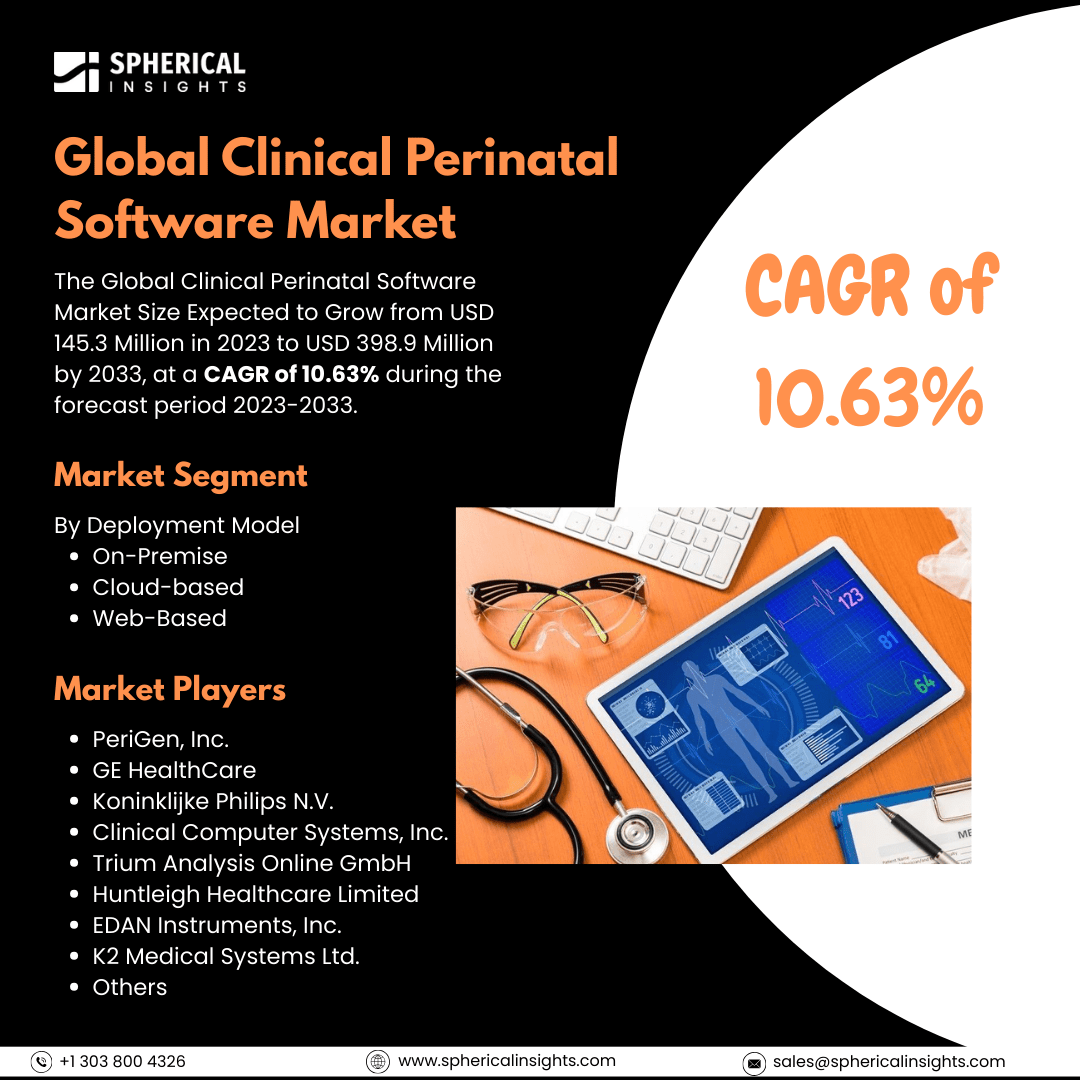Global Clinical Perinatal Software Market Size to Exceed USD 398.9 Million by 2033
According to a research report published by Spherical Insights & Consulting, The Global Clinical Perinatal Software Market Size Expected to Grow from USD 145.3 Million in 2023 to USD 398.9 Million by 2033, at a CAGR of 10.63% during the forecast period 2023-2033.
Browse 210 market data Tables and 45 Figures spread through 190 Pages and in-depth TOC on the Global Clinical Perinatal Software Market Size, Share, and COVID-19 Impact Analysis, By Deployment Model (On–Premise, Cloud–Based, and Web-Based), By Application (Fetal Monitoring, Workflow Management, Patient Documentation, EMR Workflow Management, and Others), and By Region (North America, Europe, Asia Pacific, Latin America, Middle East, and Africa), Analysis and Forecast 2023 – 2033
The clinical perinatal software market is the sector dealing with software solutions that aim to assist health professionals in the management and tracking of maternal and fetal well-being throughout pregnancy, labor, and childbirth. Such solutions augment clinical decision support, patient safety, and workflow efficiencies in obstetrics and neonatology units. Moreover, the clinical perinatal software Market is fueled by mounting maternal and infant health issues, rising adoption of electronic health records (EHR), advances in fetal monitoring technology, and escalating demand for data-driven decision-making. Furthermore, government efforts toward improving maternal care, the use of AI and cloud-based technologies, and workflow automation needs in hospitals also propel market growth. However, major constraints are prohibitively high installation costs, issues of data security, incompatibility with hospital systems already installed, low awareness in developing areas, and refusal to adopt technology by medical staff, slowing the growth of widespread markets.
The on-premise segment accounted for the largest share of the global clinical perinatal software market in 2023 and is anticipated to grow at a significant CAGR during the forecast period.
Based on the deployment model, the global clinical perinatal software market is divided into on-premise, cloud-based, and web-based. Among these, the on-premise segment accounted for the largest share of the global clinical perinatal Software market in 2023 and is anticipated to grow at a significant CAGR during the forecast period. Healthcare facilities and hospitals prefer on-premise solutions because of increased data security, regulatory compliance, and greater control over patient data. Cloud-based solutions are increasingly being adopted because of scalability, remote access, and cost savings.
The fetal monitoring segment accounted for a substantial share of the global clinical perinatal Software market in 2023 and is anticipated to grow at a rapid pace during the projected period.
On the basis of the application, the global clinical perinatal software market is divided into fetal monitoring, workflow management, patient documentation, EMR workflow management, and others. Among these, the fetal monitoring segment accounted for a substantial share of the global clinical perinatal software market in 2023 and is anticipated to grow at a rapid pace during the projected period. The growing emphasis on fetal and maternal well-being, high-risk pregnancies, and advances in real-time monitoring fuel its prevalence. Maternity clinics and hospitals opt for fetal monitoring to identify complications at the earliest and enhance patient outcomes.
North America is projected to hold the largest share of the global clinical perinatal software market over the projected period.
North America is projected to hold the largest share of the global clinical perinatal software market over the projected period. This is propelled by sophisticated healthcare infrastructure, high usage of electronic health records (EHR), and excellent government backing for women's health. The availability of prominent market players and the growing demand for innovative fetal monitoring solutions further enhance regional leadership.
Asia Pacific is expected to grow at the fastest CAGR of the global clinical perinatal software market during the projected period. This is driven by growing healthcare investments, rising awareness of maternal health, and growing hospital infrastructure. The fast growth of digital health solutions, rising government initiatives, and a rise in high-risk pregnancies also drive market growth, particularly in nations such as China, India, and Japan.
Company Profiling
Major vendors in the global clinical perinatal software market are PeriGen, Inc., GE HealthCare, Koninklijke Philips N.V., Clinical Computer Systems, Inc., Trium Analysis Online GmbH, Huntleigh Healthcare Limited, EDAN Instruments, Inc., K2 Medical Systems Ltd., and others.
Key Target Audience
- Market Players
- Investors
- End-users
- Government Authorities
- Consulting and Research Firm
- Venture capitalists
- Value-Added Resellers (VARs)
Recent Development
- In August 2023, PeriGen Inc. introduced the LaborWatch platform, a game-changing AI-driven solution for maternal-fetal monitoring. After successful deployment in a large U.S. health system, LaborWatch employs artificial intelligence to track labor progression and alert staff to ongoing problems through automated SMS alerts. The innovative technology improves healthcare providers' capacity to monitor and respond to critical issues in real-time, enhancing patient outcomes during labor and delivery.
Market Segment
This study forecasts revenue at global, regional, and country levels from 2023 to 2033. Spherical Insights has segmented the global clinical perinatal software market based on the below-mentioned segments:
Global Clinical Perinatal Software Market, By Deployment Model
- On-Premise
- Cloud-based
- Web-Based
Global Clinical Perinatal Software Market, By Application
- Fetal Monitoring
- Workflow Management
- Patient Documentation
- EMR Workflow Management
- Others
Global Clinical Perinatal Software Market, By Regional
- North America
- Europe
- Germany
- UK
- France
- Italy
- Spain
- Russia
- Rest of Europe
- Asia Pacific
- China
- Japan
- India
- South Korea
- Australia
- Rest of Asia Pacific
- South America
- Brazil
- Argentina
- Rest of South America
- Middle East & Africa
- UAE
- Saudi Arabia
- Qatar
- South Africa
- Rest of the Middle East & Africa



